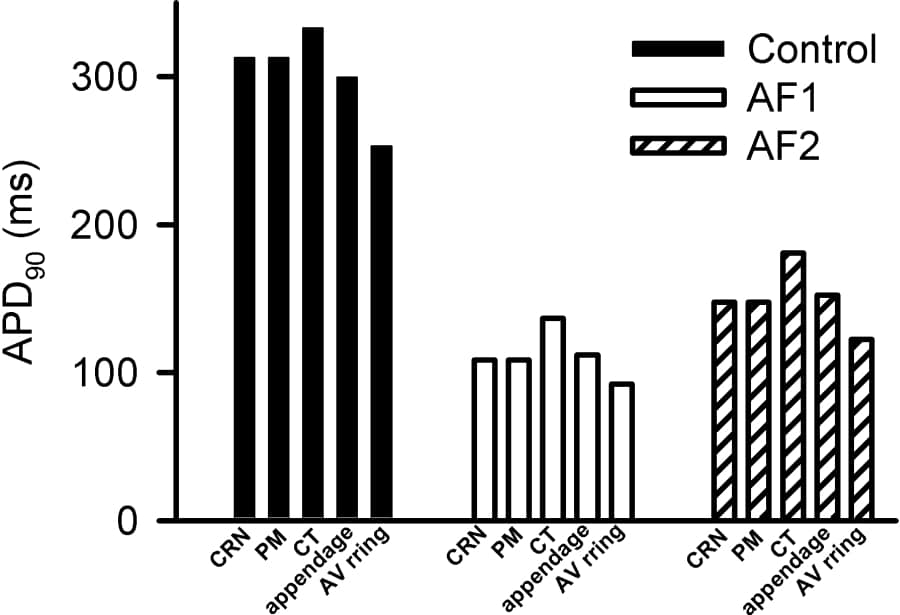Introduction: Human atria are composed of electrically heterogeneous tissues [1]. We postulated that electrical remodelling induced by chronic atrial fibrillation (AF) enhances heterogeneity and facilitates AF. Methods: We modified the Courtemanche et al. [2] model to simulate action potentials (APs) in human atrial cells types, i.e. atrial chambers (CRN), pectinate muscle (PM), cristae terminalis (CT), atrioventricular ring (AV ring) and atrial appendage [1]. We further incorporated experimental data of AF induced electrical remodelling (AFER) based on studies by Bosch et al. (AF1) [3] and Workman et al. (AF2) [4]. Single cell models were then incorporated into spatial models with realistic 2D geometry of human atria. Using these models, we quantified the effects of AFER on atrial AP profiles, AP duration (APD90), rate dependency of AP duration (APDr), effective refractory period (ERPr) and intra-atrial conduction velocity (CVr). Effects of AFER on atrial tissue’s vulnerability to uni-directional conduction block (VW) and the dynamical behaviour of re-entrant excitation waves in 2D electrically heterogeneous realistic models were studied. Results: AFER inhomogenously abbreviated atrial APD90‘s with the largest reduction in the CT (Control: 333.0 ms; AF1: 136.6 ms; AF2: 181.0 ms) and the smallest reduction in the AV ring APD (Control: 253.2 ms; AF1: 92.0 ms; AF2: 122.5 ms). The effects of AF on cellular APD90‘s are shown in Figure 1. AFER reduced ERP dramatically for all tissue types. AFER reduced atrial excitability leading to a slower intra-atrial electrical conduction. However, AFER facilitated electrical conduction at much higher pacing rates compared to Control tissue. The measured maximal rates for atrial excitation conduction in CT tissue were 198, 421, 325 and 198 beats/minute for the Control, AF1 and AF2 cases respectively. AFER reduced tissue’s VW in all tissue types. AFER induced inhomogeneous alterations in the electrical properties had a direct impact on the dynamical behaviours of re-entrant waves. Under Control conditions re-entrant waves self terminated with a life span of 1800 ms. However, under AF conditions, re-entrant waves were sustained and led to persistent erratic propagating wavelets. Conclusions: AFER augmented spatial heterogeneity in atrial electrical properties, which is pro-arrhythmic as it helped sustain re-entrant waves. This study provides an insight into the mechanisms underlying “AF begets AF”.
University of Cambridge (2008) Proc Physiol Soc 11, C20
Oral Communications: Effects of atrial fibrillation on electrically heterogeneous human atria: a computer modelling study
S. Kharche1, J. Stott1, P. Law1, H. Dobrzynski2, H. Zhang1
1. School of Physics and Astronomy, University of Manchester, Manchester, United Kingdom. 2. School of Medicine, University of Manchester, Manchester, United Kingdom.
View other abstracts by:
Figure 1. APD90 heterogeneity in human atrium and the effects of AF on APD90. Data shows APD90 for atrial chambers (CRN) PM CT appendage and AV ring under Control (solid bars) AF1 (empty bars) and AF2 (striped bars) conditions. The average APD90 reductions were 65% due to AF1 and 52% due to AF2.
Where applicable, experiments conform with Society ethical requirements.

